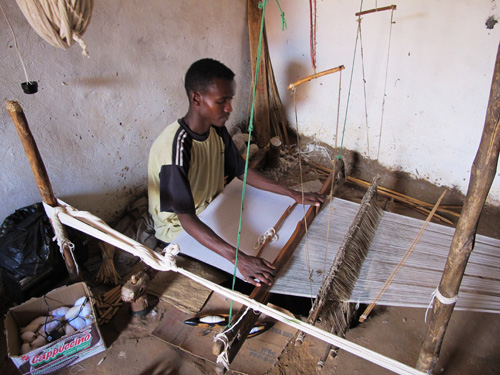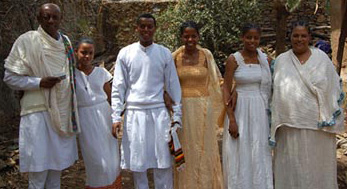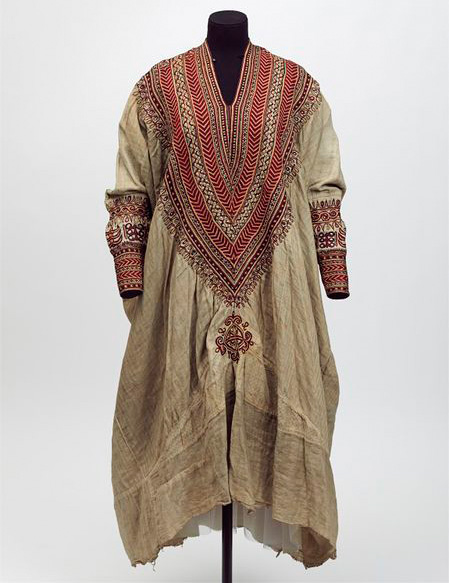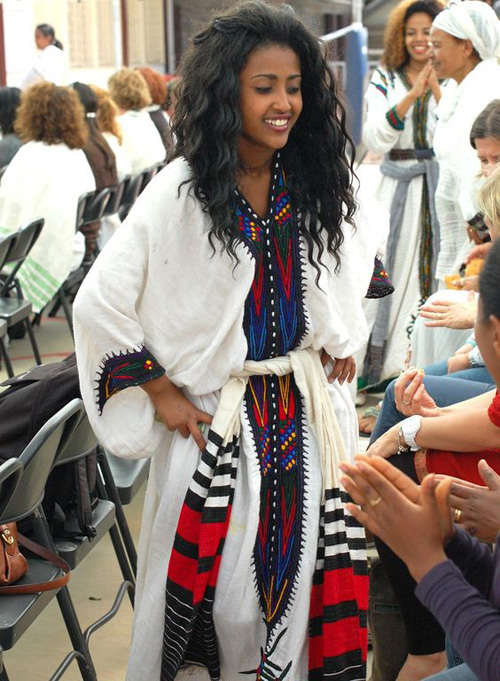 Ethiopian people still wear their traditional clothes rather often. Older people and the citizens from the rural area use the folk dress every day. Though in large cities, Ethiopians prefer the western-style clothing, they also get their traditional costumes out of the closet during the festivals, weddings, and national celebrations. It’s not just because of clothing traditions and customs, but also the climate and weather conditions of Ethiopia. The folk costumes were designed to fit the peculiarities of this country perfectly, to give locals the protection from the vagaries of weather, and to make them feel comfortable.
Ethiopian people still wear their traditional clothes rather often. Older people and the citizens from the rural area use the folk dress every day. Though in large cities, Ethiopians prefer the western-style clothing, they also get their traditional costumes out of the closet during the festivals, weddings, and national celebrations. It’s not just because of clothing traditions and customs, but also the climate and weather conditions of Ethiopia. The folk costumes were designed to fit the peculiarities of this country perfectly, to give locals the protection from the vagaries of weather, and to make them feel comfortable.
The traditional outfit of the country always stems from its climate and landscape. That’s because the folk dress is the creation of evolution. It is being formed during dozens of years, sometimes centuries, and then is used during even longer periods of time. But the folk dress never stops changing. Inventing new fabrics, new methods of manufacturing, new techniques of weaving, sewing, embroidering, and decorating the costume, – all of this influences the traditional outfit of any country in the world. And Ethiopia, of course, is no exception.

Ethiopian traditional loom. Almost every family has one to make shemma, hand-woven cotton fabric. Photo from Ai.stanford.edu
Ethiopian landscape and climate are diverse. That’s why there are many variations of the folk costume of Ethiopia. Locals from the highland territories use heavier clothes to protect their bodies from the cold, precipitation, and winds. People from the lowland plains wear very light-weight and light-colored attires to protect the body from the dry heat and the sun. Despite the large variety of folk clothes in Ethiopia, the conventional national costume is a long white cotton outfit, often embellished with colorful embroidery.
Each ethnic group or tribe that lives in Ethiopia has its own peculiarities of the traditional outfit. As we’ve said earlier, the conventional costume of the country is a long white cotton outfit, but there are some other variations. For example, the Muslim women of Harar use red, black, or purple dresses as the folk costumes. The Oromo and Bale people wear leather garments. Afar people use brightly colored cotton wraps. But the main difference between various ethnic groups, the main identification features are not in the dress design or color. They are in the embroidery patterns, jewelry, and hairstyles. For example, Bale children wear their heads shaved; Hamer, Geleb, Bume and Karo males plait their hair and use clay to hold the traditional feathered headdress in place; Amhara and Tigray women braid a lot of plaits on their heads; Harar females make two buns of hair, one behind each ear. We wouldn’t even begin to describe the differences between the embroidery designs on the traditional garbs – there are so many various patterns and color combinations.
Male traditional costume
The national men’s outfit of Ethiopia consists of white trousers, white knee-length shirt, sometimes a sweater, and a piece of cloth (a shawl called “gabi”) on top. The clothing is traditionally snow-white. In some cases, the pieces are decorated with beautiful colorful embroidery. Usually, there is a small amount of embroidery around the collar, or/and on the front part of the shirt.

Ethiopian men and women in traditional costumes. You can see male sweater and shawl, important parts of folk clothing. Photo from Web.linkethiopia.org
Gabi is the equivalent of women’s shawl called “netela”, but it is thicker and warmer. It is worn over the shoulders of a man. Gabi is a kind of a light blanket rather than a scarf. The ends of the gabi can be adorned with some embroidery but not much.
The male folk costume may include knee-high socks as well.
Female traditional costume
The national costume of Ethiopian women is called “habesha kemis”. It consists of a long white dress embellished with embroidery and a white shawl called “netela”. Sometimes females use a few shawls or scarves, one for the head and one around the shoulders.
The dress is made from the cotton cloth called “shemma”. Traditionally, it is a hand-woven fabric 90 cm wide and several meters long. The strips of cloth are sewn together to make the dress. Often, shiny threads are woven into the fabric to make it look more festive and rich.

Ethiopian vintage female dress, 1860. Cotton embroidered with silk. It belonged to Queen Woyzaro Terunesh, the 2nd wife of the Ethiopian emperor Tewodros. The dress is in Victoria and Albert Museum in London. Photo from Vam.ac.uk
Women’s garments are usually adorned with colorful embroidery; in some cases, with pretty large amounts of embroidery. The dresses may be embroidered around the collar, on the cuffs and sleeves, on the hem, and on the front part.
The female shawl, so-called “netela”, is a kind of scarf made from very thin and delicate cotton. It is rather large, about 63 x 102 inches (160 x 260 cm). The ends of the shawl are usually embellished with multicolor embroidery; the color and pattern match those on the main garment. There are many different ways of draping the netela, each has its own meaning. For general wear, the shawl covers the shoulders and back, the embroidered end is folded over the right shoulder. For religious occasions, the netela is draped over the shoulders and back with the embroidered ends over both shoulders. For mourning, the shawl is draped in a way when the embroidered end goes around the face. When the woman is relaxing and resting, the netela is worn with the embroidered end over the left shoulder.

Ethiopian woman wearing folk dress of Ethiopia with traditional colorful embroidery. Photo from Rootsethiopia.org
But netela is not the only shawl worn by Ethiopian women. There are a few other similar garments. One of them is called “fota”. It is a brighter shawl, 58 x 105 inches (147 x 268 cm) large. The pattern on the fota is usually checkered. The cloth is simply wrapped around the shoulders and over the head. Another hand-woven shawl is called “doncho”. It is worn only by married women. Doncho is very long, sometimes up to 26 feet (8 meters) long.
Jewelry complements the traditional female attire of Ethiopia. Women use gold or silver necklaces and bracelets on the wrists and ankles. Heavy ivory, brass, and copper bracelets and anklets are used as well.



Thank you so much. We're happy to be useful and to share knowledge with you.